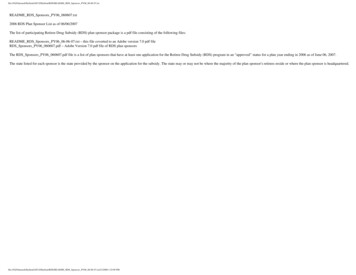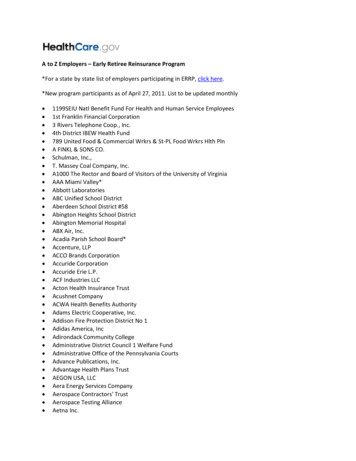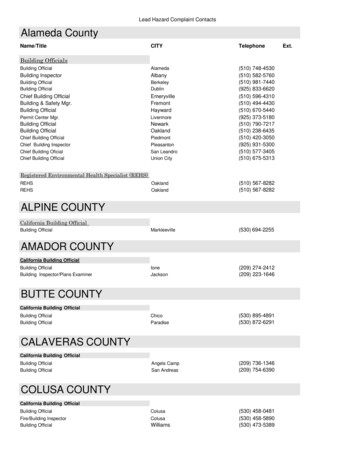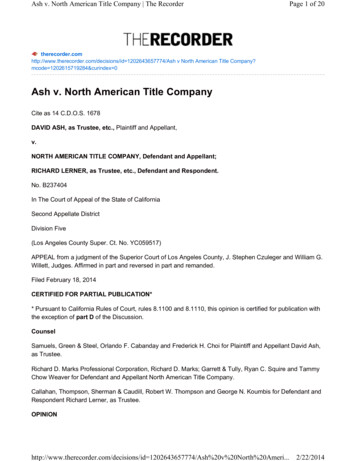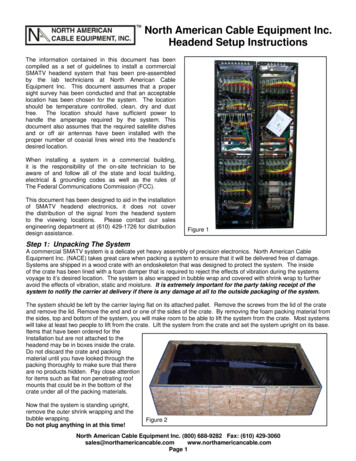
Transcription
Building aNorth AmericanCommunity
Building aNorth AmericanCommunityReport of anIndependent Task ForceSponsored by the Council on Foreign Relationswith theCanadian Council of Chief Executives and theConsejo Mexicano de Asuntos Internacionales
Founded in 1921, the Council on Foreign Relations is an independent, national membershiporganization and a nonpartisan center for scholars dedicated to producing and disseminatingideas so that individual and corporate members, as well as policymakers, journalists, students,and interested citizens in the United States and other countries, can better understand theworld and the foreign policy choices facing the United States and other governments. TheCouncil does this by convening meetings; conducting a wide-ranging Studies program; publishing Foreign Affairs, the preeminent journal covering international affairs and U.S. foreign policy;maintaining a diverse membership; sponsoring Independent Task Forces; and providing upto-date information about the world and U.S. foreign policy on the Council’s website,www.cfr.org.THE COUNCIL TAKES NO INSTITUTIONAL POSITION ON POLICY ISSUESAND HAS NO AFFILIATION WITH THE U.S.GOVERNMENT. ALLSTATEMENTSOF FACT AND EXPRESSIONS OF OPINION CONTAINED IN ITS PUBLICATIONS ARE THE SOLE RESPONSIBILITY OF THE AUTHOR OR AUTHORS.The Council will sponsor an Independent Task Force when (1) an issue of current and criticalimportance to U.S. foreign policy arises, and (2) it seems that a group diverse in backgroundsand perspectives may, nonetheless, be able to reach a meaningful consensus on a policy throughprivate and nonpartisan deliberations. Typically, a Task Force meets between two and fivetimes over a brief period to ensure the relevance of its work.Upon reaching a conclusion, a Task Force issues a report, and the Council publishes its textand posts it on the Council website. Task Force reports reflect a strong and meaningful policyconsensus, with Task Force members endorsing the general policy thrust and judgmentsreached by the group, though not necessarily every finding and recommendation. Task Forcemembers who join the consensus may submit additional or dissenting views, which are includedin the final report. Upon reaching a conclusion, a Task Force may also ask individuals whowere not members of the Task Force to associate themselves with the Task Force reportto enhance its impact. All Task Force reports ‘‘benchmark’’ their findings against currentadministration policy in order to make explicit areas of agreement and disagreement. TheTask Force is solely responsible for its report. The Council takes no institutional position onthe findings or recommendations in the report. The Task Force on the Future of NorthAmerica is sponsored by the Council on Foreign Relations with the Canadian Council ofChief Executives and the Consejo Mexicano de Asuntos Internacionales.
For further information about the Council or this Task Force, please write to the Councilon Foreign Relations, 58 East 68th Street, New York, NY 10021, or call the Director ofCommunications at 212-434-9400. Visit our website at www.cfr.org.Founded in 1976, the Canadian Council of Chief Executives (CCCE) is Canada’s premierbusiness association, with an outstanding record of achievement in matching entrepreneurialinitiative with sound public policy choices. Composed of the chief executives of 150 leadingCanadian enterprises, the CCCE was the Canadian private sector leader in the developmentand promotion of the Canadian-U.S. Free Trade Agreement during the 1980s and of thesubsequent trilateral North American Free Trade Agreement.The Consejo Mexicano de Asuntos Internacionales (COMEXI) is the only multidisciplinaryorganization committed to fostering sophisticated, broadly inclusive political discourse andanalysis on the nature of Mexico’s participation in the international arena and the relativeinfluence of Mexico’s increasingly global orientation on domestic priorities. The Council isan independent, nonprofit, pluralistic forum, with no government or institutional ties, that isfinanced exclusively by membership dues and corporate support. The main objectives ofCOMEXI are to provide information and analysis of interest to our associates, as well as tocreate a solid institutional framework for the exchange of ideas concerning pressing worldissues that affect our country.Copyright 2005 by the Council on Foreign Relations威, Inc.All rights reserved.Printed in the United States of America.This report may not be reproduced in whole or in part, in any form beyond the reproductionpermitted by Sections 107 and 108 of the U.S. Copyright Law Act (17 U.S.C. Sections 107and 108) and excerpts by reviewers for the public press, without express written permissionfrom the Council on Foreign Relations. For information, write to the Publications Office,Council on Foreign Relations, 58 East 68th Street, New York, NY 10021.
Task Force Co-ChairsJohn P. ManleyPedro AspeWilliam F. WeldVice ChairsThomas P. d’AquinoAndrés RozentalRobert A. Pastor
Task Force MembersPedro AspeThomas S. Axworthy*Heidi S. Cruz*Nelson W. Cunningham*Thomas P. d’AquinoAlfonso de AngoitiaLuis de la Calle Pardo*Wendy K. Dobson*Richard A. Falkenrath*Rafael Fernández de CastroRamón Alberto GarzaGordon D. GiffinAllan Gotlieb*Michael HartCarlos Heredia*Carla A. Hills*Gary C. Hufbauer*Pierre Marc Johnson*James R. JonesChappell H. Lawson*John P. ManleyDavid McD. MannDoris M. MeissnerThomas M.T. NilesBeatriz Paredes*Robert A. Pastor*Andrés RozentalLuis RubioJeffrey J. Schott*William F. WeldRaul H. Yzaguirre*The individual has endorsed the report and submitted an additional or a dissenting view.
ContentsForewordxviiAcknowledgmentsxixTask Force Report1Introduction1Recommendations7Making North America Safer7Creating a North American Economic Space18From Vision to Action: Institutions to GuideTrinational Relations30Conclusion32Additional and Dissenting Views33Task Force Members40Task Force Observers47
Tables des matièresListe des membres du Groupe de travail52Avant-propos53Remerciements55Rapport du Groupe de travail57Introduction59Recommandations66Rendre l’Amérique du Nord plus sécuritaire66Créer un espace économique nord-américain79De la vision à l’action: Institutions pour guiderles relations tripartites93Conclusion95Déclarations supplémentaires et points de désaccord97Les membres du Groupe de travail105Observateurs du Groupe de travail113
ContenidoLista de los miembros del Grupo de Trabajo118Prólogo119Reconocimientos121Informe del Grupo de a una América del Norte más segura132Creación de un Espacio Económico de Américadel Norte144De la visión a la acción: Instituciones para guiarlas relaciones trinacionales158Conclusión160Posturas adicionales y disidentes161Miembros del Grupo de Trabajo168Observadores del Grupo de Trabajo176
ForewordAmerica’s relationship with its North American neighbors rarely getsthe attention it warrants. This report of a Council-sponsored Independent Task Force on the Future of North America is intended to helpaddress this policy gap. In the more than a decade since the NorthAmerican Free Trade Agreement (NAFTA) took effect, ties amongCanada, Mexico, and the United States have deepened dramatically.The value of trade within North America has more than doubled.Canada and Mexico are now the two largest exporters of oil, naturalgas, and electricity to the United States. Since 9/11, we are not onlyone another’s major commercial partners, we are joined in an effortto make North America less vulnerable to terrorist attack.This report examines these and other changes that have taken placesince NAFTA’s inception and makes recommendations to address therange of issues confronting North American policymakers today: greatereconomic competition from outside North America, uneven development within North America, the growing demand for energy, andthreats to our borders.The Task Force offers a detailed and ambitious set of proposals thatbuild on the recommendations adopted by the three governments atthe Texas summit of March 2005. The Task Force’s central recommendation is establishment by 2010 of a North American economic andsecurity community, the boundaries of which would be defined by acommon external tariff and an outer security perimeter.Unlike previous Council-sponsored Task Forces, this projectwas international, or trinational to be precise. The membership wasxvii
xviiiBuilding a North American Communitycomprised of policy practitioners, scholars, and business leaders fromeach of the three countries. The Task Force held meetings in Toronto,New York, and Monterrey. In this effort, the Council partnered withtwo outstanding institutions, the Canadian Council of Chief Executivesand the Consejo Mexicano de Asuntos Internacionales. I thank themfor their collaboration, collegiality, and support. We were extremelylucky that three experienced and dedicated North Americans—JohnP. Manley, Pedro Aspe, and William F. Weld—agreed to lead thiseffort. My appreciation as well goes to vice-chairs Thomas P. d’Aquino,Andrés Rozental, and Robert A. Pastor, project director Chappell H.Lawson, and Lee Feinstein, executive director of the Council’s TaskForce program. This report simply would not have been possiblewithout their commitment, dedication, and expertise. Finally, I wantto thank the Task Force members for the tremendous intellectual andtime commitment they have made to this project, resulting in a valuableand lasting contribution to a subject of great importance to our threecountries and beyond.Richard N. HaassPresidentCouncil on Foreign RelationsMay 2005
AcknowledgmentsA Task Force is only as good as its chairmen. This Task Force benefitedimmeasurably from the intellectual leadership and commitment ofJohn P. Manley, Pedro Aspe, and William F. Weld. Their determination, humor, and good judgment brought this Task Force to a strongconsensus. We were fortunate, also, to have had three highly knowledgeable and energetic vice chairs: Thomas P. d’Aquino, AndrésRozental, and Robert A. Pastor. We are grateful to the Task Forcemembership, an impressive and dedicated group of Canadians, Mexicans, and Americans committed to building a more prosperous andsecure North America. We thank Chappell H. Lawson, project director,for his fine contributions to the Task Force’s work.The Task Force thanks Canada’s deputy prime minister and ministerof public safety and emergency preparedness, Anne McLellan, andSuncor Energy Inc. President and Chief Executive Officer RichardGeorge, who briefed the group in Toronto in October 2004; U.S.Senator John Cornyn (R-TX), Mexican Consul General Arturo Sarukhan, Hess Energy Trading Company Executive Adviser Edward L.Morse, and Director of the Center for Brazilian Studies at ColumbiaUniversity Albert Fishlow, for theircontributions to the meetingin NewYork in December 2004; and Nuevo Leon Governor Jose NatividadGonzalez Paras and North American Development Bank Director RaulRodriguez, who met with the Task Force in Monterrey in February2005. In addition, the following individuals helped to ensure threeproductive Task Force sessions and deserve our hearty thanks: Danxix
xxBuilding a North American CommunityGerstein, Eric Hrubant, Ramón Alberto Garza, and Eva Tamez. NoraWeiss, Elena Rich, Marcela Pimentel Lusarreta, Jorge Anaya, andAndrés Rozental lent their impressive translation skills to the effort.Convening a trinational Task Force is a tremendous undertaking.It would not have been possible without the support of the CanadianCouncil of Chief Executives and the Consejo Mexicano de AsuntosInternacionales, which joined with the Council on Foreign Relationsin this effort.At the Council on Foreign Relations, we would like to thankCouncil President Richard N. Haass, who proposed this Task Forceand supported it throughout. Lisa Shields, Anya Schmemann, KateZimmerman, John Havens, Nancy Bodurtha, Meaghan Mills, PatriciaDorff, and Irina Faskianos helped to ensure that the Task Force’s workreceived the attention of policymakers and press. Special thanks go toour colleagues on the Task Force staff, specifically Task Force ProgramAssistant Director Lindsay Workman and Research Associate AndreaWalther. This report would not have been possible without theirexpertise and dedication.At the Canadian Council of Chief Executives (CCCE), we wouldlike to recognize Executive Vice President David Stewart-Patterson,who provided significant editorial contributions, along with his colleagues Sam Boutziouvis, Nancy Wallace, Ross Laver, Cheryl Eadie,and Monique Kaymond-Duré. We also would like to thank the member chief executive officers whose companies support the CCCE’sNorth American Security and Prosperity Initiative, which funded the CCCE’scontribution to the work of the Task Force.At the Consejo Mexicano de Asuntos Internacionales (COMEXI),our appreciation goes to its director, Aurora Adame, and to her able staff.Finally, we are grateful to the Archer Daniels Midland Company,Merrill Lynch & Co., and Yves-Andre Istel for the generous financialsupport each provided for the work of this Task Force.Lee FeinsteinExecutive Director, Task Force Program
Task Force Report
IntroductionThe security and well-being of its citizens are at the pinnacle of anygovernment’s responsibilities. At the beginning of the twenty-first century, the futures of Canada, Mexico, and the United States are sharedas never before. As a result, all three countries face a historic challenge:Do they continue on the path of cooperation in promoting moresecure and more prosperous North American societies, or do theypursue divergent and ultimately less secure and less prosperous courses?To ask the question is to answer it; and yet, if important decisionsare not pursued and implemented, the three countries may well findthemselves on divergent paths. Such a development would be a tragicmistake, one that can be readily avoided if they stay the course andpursue a series of deliberate and cooperative steps that will enhanceboth the security and prosperity of their citizens.At their meeting in Waco, Texas, at the end of March 2005,U.S. President George W. Bush, Mexican President Vicente Fox, andCanadian Prime Minister Paul Martin committed their governmentsto a path of cooperation and joint action. We welcome this importantdevelopment and offer this report to add urgency and specific recommendations to strengthen their efforts.The three countries of North America are each other’s largesttrading partners. More than 80 percent of Canadian and Mexican tradeis with its North American Free Trade Agreement (NAFTA) partners.Almost one-third of U.S. trade is with Canada and Mexico. Tradeamong these three countries has tripled in value over the past decade.1
2Building a North American CommunityIn addition, cross-border direct investment has increased sharply, contributing to the integration of the three economies.North America is also energy interdependent, though not energyindependent. In 2004, Canada and Mexico were the two largest exporters of oil to the United States. Canada supplies the United Stateswith roughly 90 percent of its imported natural gas and all of itsimported electricity.In addition, all three countries face common security dangers, fromterrorism to drugtrafficking tointernational organized crime. Addressingthese dangers is a major challenge in this dynamic region: the bordersbetween Canada, the United States, and Mexico will be crossed over400 million times in 2005.As liberal democracies, the governments also share common principles: protecting individual rights, upholding the rule of law, and ensuringequality of opportunity for their citizens. North America, in short, ismore than an expression of geography. It is a partnership of sovereignstates with overlapping economic and security interests, where majordevelopments in one country can and do have a powerful impact onthe other two.More than a decade ago NAFTA took effect, liberalizing tradeand investment, providing crucial protection for intellectual property,creating pioneering dispute-resolution mechanisms, and establishing thefirst regional devices to safeguard labor and environmental standards.NAFTA helped unlock the region’s economic potential and demonstrated that nations at different levels of development can prosper fromthe opportunities created by reciprocal free trade arrangements.Since then, however, global commercial competition has grownmore intense and international terrorism has emerged as a seriousregional and global danger. Deepening ties among the three countriesof North America promise continued benefits for Canada, Mexico,and the United States. That said, the trajectory toward a more integratedand prosperous North America is neither inevitable nor irreversible.In March 2005, the leaders of Canada, Mexico, and the UnitedStates adopted a Security and Prosperity Partnership of North America(SPP), establishing ministerial-level working groups to address key security and economic issues facing North America and setting a short
Introduction3deadline for reporting progress back to their governments. PresidentBush described the significance of the SPP as putting forward a commoncommitment ‘‘to markets and democracy, freedom and trade, andmutual prosperity and security.’’ The policy framework articulated bythe three leaders is a significant commitment that will benefit frombroad discussion and advice. The Task Force is pleased to providespecific advice on how the partnership can be pursued and realized.To that end, the Task Force proposes the creation by 2010 ofa North American community to enhance security, prosperity, andopportunity. We propose a community based on the principle affirmedin the March 2005 Joint Statement of the three leaders that ‘‘oursecurity and prosperity are mutually dependent and complementary.’’Its boundaries will be defined by a common external tariff and an outersecurity perimeter within which the movement of people, products,and capital will be legal, orderly, and safe. Its goal will be to guaranteea free, secure, just, and prosperous North America.What We FaceOur countries face three common challenges:Shared security threats. Over the last decade, terrorist and criminalactivity has underscored North America’s vulnerability. All of the9/11 terrorists succeeded in entering the United States directly fromoutside North America, but the 1999 arrest of a person trying to crossthe Canadian-U.S. border as part of a plot to bomb the Los Angelesairport shows that terrorists may also try to gain access to the UnitedStates through Canada and Mexico. This person was found to havecased Canadian targets as well, and al-Qaeda has publicly listed Canadaas one of its prime targets along with the United States.Failure to secure the external borders of North America will inhibitthe legitimate movement of people and goods within the continent.After the 9/11 attacks, delays at the Canadian-U.S. border promptedparts shortages in both countries, costing manufacturers millions ofdollars an hour. Trade across the Mexican-U.S. border also suffered inthe immediate aftermath of the attacks, which hindered U.S. economicgrowth. Continent-wide consequences mean that Canada and Mexico
4Building a North American Communityhave an overriding commercial interest in increasing North Americansecurity, apart from any other considerations. In addition, future terroristassaults could target critical infrastructure or sites in any of the three countries.Beyond terrorism, all three countries must deal with a persistentflow of undocumented immigrants. International criminal activity alsoposes a continuing threat to public safety in the region, including drugand gang-related violence along the Mexican-U.S. frontier. These crossborder threats cannot be adequately addressed by any one government alone.Failure to address security issues will ultimately undermine gains onother matters. In the North American context, failure to collaborateeffectively to address security issues will have a direct impact on commercial relationships as well as on our freedoms and quality of life.Shared challenges to our economic growth and development.NAFTA has dramatically enhanced our ability to make better use of theabundant resources of our three countries and thus made an importantcontribution to economic growth within North America. Over thelast decade, however, our economies have faced growing challengesin increasingly competitive and globalized world markets. We need todo more to ensure that our policies provide our firms and workers witha fair and unfettered basis to meet the challenges of global competition.Unwieldy North American rules of origin, increasing congestion atour ports of entry, and regulatory differences among our three countriesraise costs instead of reducing them. Trade in certain sectors—such asnatural resources, agriculture, and energy—remains far from free, anddisputes in these areas have been a source of disagreement among ourcountries. Furthermore, the NAFTA partners have been unable toresolve a number of important trade and investment disputes, whichhas created continuing tension in our commercial relationships.Leaders in our three countries have acknowledged these challengesand discussed a wide range of responses during the 2005 Texas summit.Those involving changes in formal trade agreements will of necessitytake time to negotiate and ratify. However, in other areas, notablyregulatory cooperation and the expansion of transborder activities in
Introduction5critical sectors such as transportation and financial services, there is ashared recognition that the three countries can and should act quicklyin ways that would make a real difference in improving the competitiveness of firms and individuals in North America.Shared challenge of uneven economic development. A fast laneto development is crucial for Mexico to contribute to the security ofthe entire region. Mexico’s development has failed to prevent deepdisparities between different regions of the country, and particularlybetween remote regions and those better connected to internationalmarkets. Northern states have grown ten times faster than those inthe center and south of the country. Lack of economic opportunityencourages unauthorized migration and has been found to be associatedwith corruption, drug trafficking, violence, and human suffering.Improvements in human capital and physical infrastructure in Mexico,particularly in the center and south of the country, would knit theseregions more firmly into the North American economy and are in theeconomic and security interest of all three countries.Leaders in our three countries have acknowledged these problemsand indicated their support for a number of promising measures, including immigration reform, but there remains considerable scope for moreindividual, bilateral, and joint efforts to address development needs.What We Can DoIn making its recommendations, the Task Force is guided by thefollowing principles: The three governments should approach continental issues togetherwith a trinational perspective rather than the traditional ‘‘dual-bilateral’’ approach that has long characterized their relationships. Progressmay proceed at two speeds in some spheres of policy. Canada andthe United States, for example, already share a long history of militarycooperation and binational defense institutions, and they shouldcontinue to deepen their bilateral alliance while opening the doorto more extensive cooperation with Mexico. Yet many issues wouldbe better addressed trinationally. Shared concerns range from regional
6 Building a North American Communityeconomic growth to law enforcement, from energy security toregulatory policy, from dispute resolution to continental defense.North America is different from other regions of the world andmust find its own cooperative route forward. A new North Americancommunity should rely more on the market and less on bureaucracy,more on pragmatic solutions to shared problems than on grandschemes of confederation or union, such as those in Europe. Wemust maintain respect for each other’s national sovereignty.Our economic focus should be on the creation of a common economic space that expands economic opportunities for all people inthe region, a space in which trade, capital, and people flow freely.The strategy needs to be integrated in its approach, recognizing theextent to which progress on each individual component enhancesachievement of the others. Progress on security, for example, willallow a more open border for the movement of goods and people;progress on regulatory matters will reduce the need for active customsadministration and release resources to boost security. North American solutions could ultimately serve as the basis for initiatives involvingother like-minded countries, either in our hemisphere or morebroadly.Finally, a North American strategy must provide real gains for allpartners and must not be approached as a zero-sum exercise. Povertyand deprivation are breeding grounds for political instability andundermine both national and regional security. The progress of thepoorest among us will be one measure of success.
RecommendationsThe recommendations of the Task Force fall into two broad categoriesthat correspond with the imperative to build a safer and more prosperouscontinent. The Task Force also proposes reforms and institutions withineach of the three governments to promote progress in these areas. TheTask Force has framed its recommendations into shorter-term measuresthat should be pursued now, and long-term steps to be implementedby 2010.Making North America SaferSecurityThe threat of international terrorism originates for the most part outsideNorth America. Our external borders are a critical line of defenseagainst this threat. Any weakness in controlling access to North Americafrom abroad reduces the security of the continent as a whole andexacerbates the pressure to intensify controls on intracontinental movement and traffic, which increases the transaction costs associated withtrade and travel within North America.September 11 highlighted the need for new approaches to bordermanagement. In December 2001, Canada and the United States signedthe Smart Border Declaration and an associated 30-point Action Planto secure border infrastructure, facilitate the secure movement of peopleand goods, and share information. A similar accord, the United StatesMexico Border Partnership Agreement, and its 22-point Action Plan,7
8Building a North American Communitywere signed in March 2002. Both agreements included measures tofacilitate faster border crossings for pre-approved travelers, developand promote systems to identify dangerous people and goods, relievecongestion at borders, and revitalize cross-border cooperation mechanisms and information sharing. The three leaders pledged additionalmeasures at their March 2005 summit meeting.The defense of North America must also consist of a more intenselevel of cooperation among security personnel of the three countries,both within North America and beyond the physical boundaries ofthe continent. The Container Security Initiative, for example, launchedby the UnitedStates inthe wake of 9/11, involves theuse of intelligence,analysis, and inspection of containers not at the border but at a growingnumber of overseas ports from which goods are shipped. The ultimategoal is to provide screening of all containers destined for any port inNorth America, so that once unloaded from ships, containers may crossland borders within the region without the need for further inspections.WHAT WE SHOULD DO NOW Establish a common security perimeter by 2010. The governments of Canada, Mexico, and the United States should articulateas their long-term goal a common security perimeter for NorthAmerica. In particular, the three governments should strive towarda situation in which a terrorist trying to penetrate our borders willhave an equally hard time doing so, no matter which country heelects to enter first. We believe that these measures should be extendedto include a commitment to common approaches toward international negotiations on the global movement of people, cargo, andvessels. Like free trade a decade ago, a common security perimeterfor North Americais an ambitious but achievable goal that will requirespecific policy, statutory, and procedural changes in all three nations. Develop a North American Border Pass. The three countriesshould develop a secure North American Border Pass with biometricidentifiers. This document would allow its bearers expedited passagethrough customs, immigration, and airport security throughout theregion. The program would be modeled on the U.S.-Canadian‘‘NEXUS’’ and the U.S.-Mexican ‘‘SENTRI’’ programs, which
Recommendations9provide ‘‘smart cards’’ to allow swifter passage to those who poseno risk. Only those who voluntarily seek, receive, and pay the costsfor a security clearance would obtain a Border Pass. The pass wouldbe accepted at all border points within North America as a complement to, but not a replacement for, national identity documentsor passports. Develop a unified North American border action plan. Theclosing of the borders following the 9/11 attacks awakened all threegovernments to the need for rethinking management of the borders.Intense negotiations produced the bilateral ‘‘Smart Borders’’ agreements. Although the two borders are different and may in certaininstances require policies that need to be implemented at two speeds,cooperation by the three governments in the following areas wouldlead to a better result than a ‘‘dual-bilateral’’ approach: Harmonize visa and asylum regulations, including convergenceof the list of ‘‘visa waiver’’ countries; H
America's relationship with its North American neighbors rarely gets the attention it warrants. This report of a Council-sponsored Indepen-dent Task Force on the Future of North America is intended to help address this policy gap. In the more than a decade since the North American Free Trade Agreement (NAFTA) took effect, ties among



